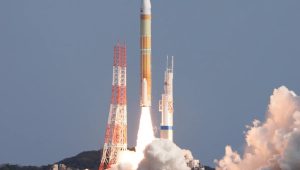Japan is gearing up for another launch attempt of its flagship rocket, the H3, this weekend, aiming to rejuvenate its space program following a setback during the booster's maiden flight last year, which disrupted satellite and planetary exploration plans.
Scheduled to launch from the Tanegashima Space Center in southern Japan on Saturday, the second flight of the H3 is anticipated to demonstrate Japan's space capabilities to its ally, the United States, in response to China's advancements in military and technology sectors.
The Japan Aerospace Exploration Agency (JAXA) has delayed the launch by two days to avoid adverse weather conditions. Developed by JAXA in collaboration with Mitsubishi Heavy Industries, the H3 is designed to replace the aging H-IIA rocket and slash launch costs by half, potentially down to as low as five billion yen ($33.2 million).
However, the H3 encountered a setback during its inaugural flight in March, prompting ground control to destroy the rocket midflight due to a failure of its second-stage engine to ignite. Despite this setback, recent successful launches of the H-IIA rocket have instilled confidence for the H3's second attempt.
The H3 rocket, measuring 63 meters (297 feet) tall, has the capacity to carry a payload of 6.5 tons into space, surpassing the H-IIA's maximum of 6 tons. Mitsubishi Heavy aims to launch six H3 rockets annually once stable production is achieved.
Apart from its domestic missions, the H3 is also expected to play a vital role in international projects, including the joint Japan-India LUPEX lunar lander mission and the U.S.-led Artemis moon exploration program.
However, Japan faces stiff competition in the global satellite launch market, with companies like SpaceX revolutionizing space transportation with reusable rockets like Falcon 9. The European Space Agency is also set to debut its lower-cost Ariane 6 rocket this year.
Masashi Okada, JAXA's H3 project manager, emphasized the need for continual efforts to adapt to market demands and competition, acknowledging the significant changes in the space industry landscape over the past decade.
Unlike SpaceX's rapid development approach, Japan's engineering style prioritizes error elimination, which has led to a meticulous process and an 11-month pause following the failed H3 launch last year, according to Ko Ogasawara, a professor at Tokyo University of Science and former Mitsubishi Heavy aerospace engineer.
In the small rocket market, Tokyo-based startup Space One is preparing to launch its Kairos rocket on March 9, while JAXA is yet to schedule the first launch of its new Epsilon S rocket. Kairos aims to become Japan's second commercial rocket series to reach space after Interstellar Technologies' MOMO in 2019.
Source | Photo: JAXA
